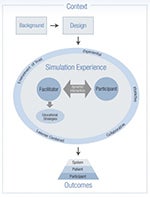6. Other Theories
|
|
|
- Transformative Learning Theory
- Example Studies in Nursing:
- Tsimane, & Downing, C. (2020). A model to facilitate transformative learning in nursing education. International Journal of Nursing Sciences, 7(3), 269–276.
https://doi.org/10.1016/j.ijnss.2020.04.006
- Tsimane, & Downing, C. (2020). Transformative learning in nursing education: A concept analysis. International Journal of Nursing Sciences, 7(1), 91–98.
https://doi.org/10.1016/j.ijnss.2019.12.006
- Cernusca, D., Thompson, S. & Riggins, J. (2018). Learning Sterile Procedures Through Transformative Reflection. Nurse Educator, 43 (6), 330-333. doi: 10.1097/NNE.0000000000000491.
- Example Studies in Medicine:
- Vipler, B., Knehans, A., Rausa, D., Haidet, P., & McCall-Hosenfeld, J. (2021). Transformative Learning in Graduate Medical Education: A Scoping Review. Journal of graduate medical education, 13(6), 801–814
https://doi.org/10.4300/JGME-D-21-00065.1
|
- Experiential Learning Theory
- Example Studies in Nursing:
- Sanderson, Mirza, N., & Correale, H. (2020). Indigenous Land-Based Experiential Learning in Nursing Education. The Journal of Nursing Education, 59(12), 721–721.
https://doi.org/10.3928/01484834-20201118-12
- McGuire, Goldstein, C., Claywell, L., & Patton, R. (2017). Analysis of Student Reflections of Experiential Learning in Nursing Health Policy Courses. Nurse Educator, 42(2), 95–99.
https://doi.org/10.1097/NNE.0000000000000321
- de Oliveira, Prado, M. L. do, Kempfer, S. S., Martini, J. G., Caravaca-Morera, J. A., & Bernardi, M. C. (2015). Experiential learning in nursing consultation education via clinical simulation with actors: Action research. Nurse Education Today, 35(2), e50–e54.
https://doi.org/10.1016/j.nedt.2014.12.016
- Lisko, & O’Dell, V. (2010). Integration of theory and practice: experiential learning theory and nursing education. Nursing Education Perspectives, 31(2), 106–108.
|
- Invitational Learning Theory
- Example Studies in Nursing:
- Watts, & Hodges, H. F. (2021). Using Invitational Theory to Examine Nursing Students’ Experiences of Their Learning Environment. Nursing Education Perspectives, 42(6), 365–370.
https://doi.org/10.1097/01.NEP.0000000000000865
|

